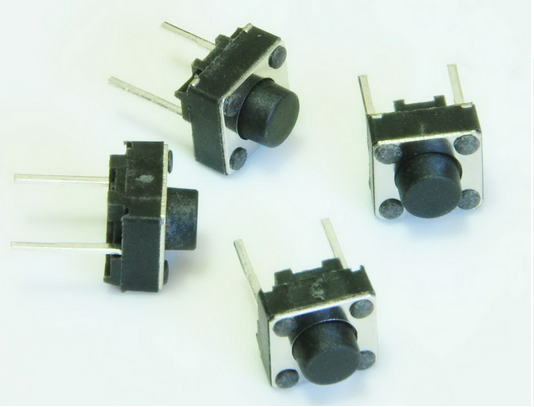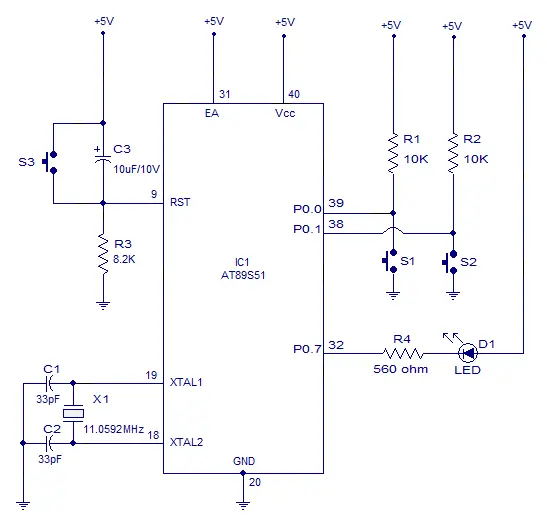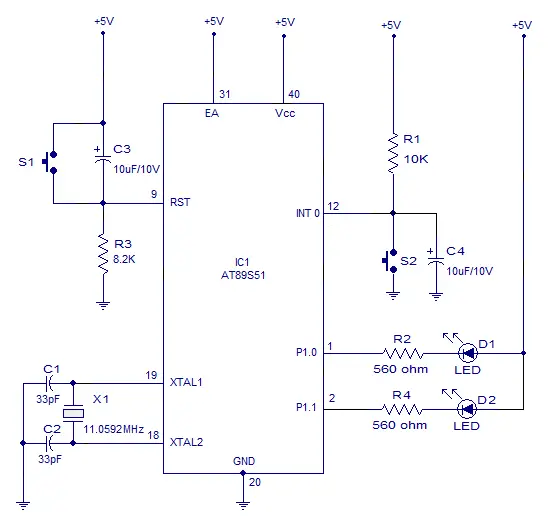This article is all about how to interface push button switches to an 8051 microcontroller. Push button switches are widely used in embedded system projects and the knowledge about interfacing them to 8051 is very essential in designing such projects. A typical push button switch has two active terminals that are normally open and these two terminals get internally shorted when the push button is depressed. Images of a typical pushbutton switch is shown below.

Circuit diagram.

The circuit diagram for interfacing push button switch to 8051 is shown above. AT89S51 is the microcontroller used here. The circuit is so designed that when push button S1 is depressed the LED D1 goes ON and remains ON until push button switch S2 is depressed and this cycle can be repeated. Resistor R3, capacitor C3 and push button S3 forms the reset circuitry for the microcontroller. Capacitor C1, C2 and crystal X1 belongs to the clock circuitry. R1 and R2 are pull up resistors for the push buttons. R4 is the current limiting resistor for LED.
Program.
MOV P0,#83H // Initializing push button switches and initializing LED in OFF state.
READSW: MOV A,P0 // Moving the port value to Accumulator.
RRC A // Checking the vale of Port 0 to know if switch 1 is ON or not
JC NXT // If switch 1 is OFF then jump to NXT to check if switch 2 is ON
CLR P0.7 // Turn ON LED because Switch 1 is ON
SJMP READSW // Read switch status again.
NXT: RRC A // Checking the value of Port 0 to know if switch 2 is ON or not
JC READSW // Jumping to READSW to check status of switch 1 again (provided switch 2 is OFF)
SETB P0.7 // Turning OFF LED because Switch 2 is ON
SJMP READSW // Jumping to READSW to read status of switch 1 again.
END
The Logic
The first instruction – MOV P0 #83H – is to turn LED off (Hex 83 in binary = 10000011) and to initialize switches 1 and 2. Switch 1 is connected to port 0.0 and switch 2 is connected to port 0.1. Also note that LED is connected to port 0.7.
Note:- Po.0 = 1 means switch 1 is OFF and Po.1 = 1 means switch 2 is OFF. P0.0 = o means switch 1 is ON and p0.1 = o means switch 2 is ON. LED turns ON when P0.7 = 0 and turns OFF when P0.7 = 1
The program has two labels – READSW and NXT. It’s all about reading switch values – that is P0.0 and P0.1. We are using RRC instruction to read switch values. The values of port 0 is moved to accumulator. Since port 0 and 1 are used to interface switches 1 and 2, we can get the values of both port bits in LSB”s 0 and 1 of accumulator by using MOV A,P0 instruction. RRC – means – rotate right through carry. You can learn more about this instruction here – 8051 programming tutorial 1 . What RRC do is simple – it will move value of port 0.0 to the carry bit. Now we can check the carry bit using instruction JC – which means “jump if carry is set” . If carry is SET – then it means port0.0 =1 and this means switch 1 is OFF. If switch 1 is OFF then we have to check status of switch 2 and that is why we jump to label NXT.
In the mean time if switch 1 is pressed – then value of port 0.0 will be equal to zero. This will get moved to accumulator and hence an RRC will result in carry bit = o. If carry bit = 0 then result of executing JC instruction is negative and it will not jump. The next instruction will get executed – that is CLR P0.7. This clears port 0.7 to zero and hence LED will turn ON. Once turned On- LED will be kept On until switch 2 is pressed.
The status of switch 2 is checked in NXT label. When NXT is executed, we are using RRC for the second time consecutively. This means, the carry bit now holds the value of P0.1 – which is status of switch 2. If carry bit = 1 then switch 2 is OFF. This means LED should not be turned OFF. If carry bit = 0 then LED should be turned OFF (The instruction SETB P0.7 turns LED OFF)
Toggling 2 LED with a pushbutton using interrupt.
This circuit demonstrates how to toggle two LEDs with a single push button using the external interrupts. Interrupt is an asynchronous signal (either hardware or software) which indicates the processor to make a change in current execution. When the processor receives a valid interrupt signal it saves the current state and then goes to execute a set of predefined steps called interrupt service routine (ISR). After executing ISR, the processor goes back to the point where it deviated and continues from there. To learn more about interrupts check this link. External interrupt handling in 8051.
Circuit diagram.

In the circuit shown above D1, D2 (the LEDs to be toggled) are connected to P1.0 and P1.1 respectively. R2 and R4 limits the current through the LEDs. The push button switch S2 is connected to the INT0 pin where R1 is a pull up resistor and C4 is the debouncing capacitor. C3, R3 and S3 forms the reset circuitry. Capacitors C2, C2 and crystal X1 are related to the clock circuitry. When powered ON LED D1 will be OFF and and LED D2 will be ON. Whenever push button switch S2 is pressed it creates an interrupt and the software makes the status of P1.o and P1.1 to toggle which gets reflected in the LEDs.
Program.
ORG 000H // starting address
SJMP LABEL //jumps to the LABEL
ORG 003H // starting address for the ISR(INT0)
ACALL ISR // calls the ISR (interrupt service routine)
RETI // returns from the interrupt
LABEL: MOV A,#10000000B // sets the initial stage of the LEDs (D1 OFF & D2 ON)
MAIN: // main function that sets the interrupt parameters
SETB IP.0 // sets highest priority for the interrupt INT0
SETB TCON.0 // interrupt generated by a falling edge signal at INT0 (pin12)
SETB IE.0 // enables the external interrupt
SETB IE.7 // enables the global interrupt control
SJMP MAIN // jumps back to the MAIN subroutine
ISR: // interrupt service routine
CPL A // complements the current value in accumulator A
MOV P1,A // moves the current accumulator value to port 1
RET // jumps to RETI
END
If you come across any doubts/errors while implementing this circuit, please feel free to ask in our comments section.

19 Comments
This is correct but i dont understand why don’t any website gives this ISR in c language. Can you provide same isr in c?
Thanks for your circuits.
It is basic for my son.
Please provide c code for this interrupt, So i can get logic for my circuit.
I am using IR slot sensor for interrupt to P89V51RD2 .
Sir i amworking on project of bidirectional visitor counter and i am facing a difficult to design a sensor so sir i would apresiate if you helf me
I have designed cross road traffic signal control system with that i am showing if a vehicle passes by night sensor would sense and road light would be turned on.
The prob I am facing is once the prog goes into ISR the main prog i.e. traffic lights gets stuck.
Please advice I want the traffic lights should continue just the road lights should be turned on for a specific time.
sir,
something like crystal is used in circuit can i know what it is and how it works.
dear sir,
kindly possible to provide c code.
thanks.
sir
can we use direct pin reding method by using instruction jb or jnb
for the same.
Can anyone please help? can i make a program that does something when i press a push button for some time?
In this circuit why have you used two switches to enable the LED. It could be easily done by using software coding..
@Balasubramanian – We wrote this article to teach LED interfacing to a micro controller. One can always do the same using codes. Thanks for the comment 🙂
led1 led2 and switch1 and switch2 on/off run by 8051, led1 on/off by switch1 and led2 on/off by switch2,code by asm51.
in thetoggling LED,s circuit the LED,s should be connected with ports 1.6 and 1.7 then thay will toggle with interrupt. at 1.0and 1.1 every time the samepattern is applied so they will not lit alternately.
if i am right please inform if not then too…..
in ur interrupt program when we push the button,the int0 becomes low and executes the isr but i had a doubt dat whether the int0 pin again becomes high after the reti instruction after releasing the push button…or we have to again make it enable(high state)
please cmmnt in urgent need of help..
can u please post a project that gives numbers with ten push buttons and 3 leds plzzzzz…..
Any one can devlope circuit for 96 keys for electronic piano for me. It should be capable for 12 keys(max) press at a time , i.e. multi key press event.
hi,
thanks for the fast response.
I appreciate this is here for learning. you have some nice articles. but in order to achieve ‘LED ON OR OFF’ all you need is a latching spdt and the LED.
This does not explain the need for all this circuitry.. and i would like to see an example of where this might be useful to me in the future.
also it seems to me c3 and r3 create a ‘de-bounce’and are not just “part of” the reset circuitry. this is worth noting as is also useful in other circuits.
what is an example use for this circuit?
@wilson – This article and circuit is for learning! – Learning abt interfacing LED and push button switches to 8051 micro controller.